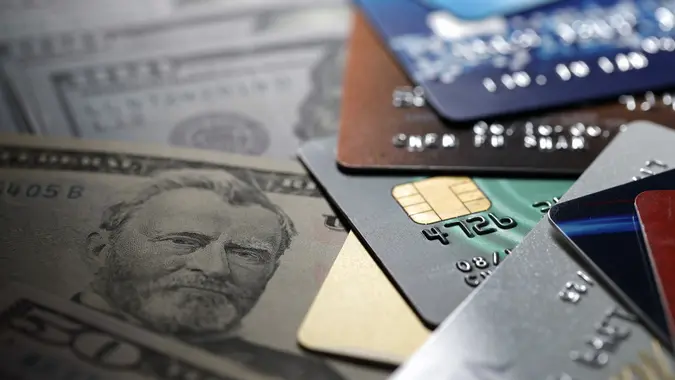How To Get Fraudulent Charges Removed From Your Credit Card

Commitment to Our Readers
GOBankingRates' editorial team is committed to bringing you unbiased reviews and information. We use data-driven methodologies to evaluate financial products and services - our reviews and ratings are not influenced by advertisers. You can read more about our editorial guidelines and our products and services review methodology.

20 Years
Helping You Live Richer

Reviewed
by Experts

Trusted by
Millions of Readers
Credit card fraud happens all the time. Unfortunately, Americans know this all too well, as the nation is the most credit fraud susceptible country in the world. According to Nilson Report, credit card fraud losses reached about $28.58 billion worldwide in 2020, with the U.S. alone responsible for more than a third of the total global loss.
So, it happens, but that doesn’t mean you just have to accept it. Take the following steps as soon as you see potentially fraudulent charges on your credit card in order to get them removed.
Contact Your Credit Card Company
The first thing to do is call your bank or issuer. It’s better to do this immediately as there are certain time limits depending on the situation. The good news is that true fraudulent charges have an unlimited time frame for which they can be claimed. This means that even if you see a fraudulent charge from a couple of months ago, you can still call your bank or credit card issuer for them to remove it.
By law, you cannot be held responsible for more than $50 in fraudulent charges. Many banks waive this and offer no liability on fraudulent charges. The FDIC recommends you also file a police report on fraudulent charges. While it is not required, it can help police track the money and helps you in case the validity of the charge is ever disputed. The potential worst part of a fraudulent charge is that it could represent a larger, ongoing violation — meaning a repeat offender.
Make Sure It’s Actually Fraudulent
Perhaps this should be the first step, but before you panic at the sight of a strange charge on your credit card, keep in mind that there could be a totally reasonable explanation. Examples of this can be forgetting to cancel a Netflix subscription, seeing it on your next bill and claiming it to be fraudulent because as far as you remember you should not have been charged. This will not qualify as a fraudulent charge, so just double check.
Check for Billing Errors
If the charge is thought to simply be a billing error, you typically have 6 days to report the charge. If you received bad service or service not rendered, this counts as its own category and you also have 60 days to report it, although it’s not guaranteed you will recover the funds.
Beware the Repeat Offense
One of the biggest things banks look out for are people taking advantage of fraudulent charge systems. Bank systems are efficient in the U.S. and cardmembers operate confidently under the assumption that fraudulent charges will be recovered and reimbursed swiftly.
Certain individuals may take advantage of this and claim something is fraudulent on their cards when they know it is not in order to receive multiple payments from the bank. Be careful not to abuse the system — whether intentionally or unintentionally — because the bank can cut this privilege off and in the future you might have a true fraudulent charge that the bank might not be willing to cover.
More From GOBankingRates
- Nearly 1 in 3 Americans Hit by a Costly Holiday Scam, Norton Survey Shows -- How To Avoid This
- Here's What the Average Social Security Payment Will Be in Winter 2025
- How Middle-Class Earners Are Quietly Becoming Millionaires -- and How You Can, Too
- The Easiest Way to Score $250 for Things You Already Do
 Written by
Written by  Edited by
Edited by 























